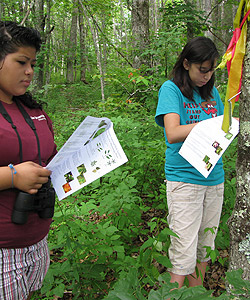Citizen scientists of all ages help uncover how the timing of natural events, such as flowering or migration, is changing from year to year in the Great Smoky Mountains.

NPS/Susan Sachs
When do wood frogs begin to call? When do wildflowers bloom? When do songbirds return?
These are questions of phenology, the study of the timing of natural events in plants and animals. Because phenology can be influenced by variations in climate, it may be used an indicator of the effects of climate change on national parks and the plants and animals they contain.
Great Smoky Mountains National Park has a long record of phenological events. In the 1930s–1940s, the park's first naturalist, Arthur Stupka, made more than 18,000 observations of natural happenings in the park—when flowers bloomed, when migratory birds arrived. Today, resource managers and educators are working to gather data to compare to those early records to see what changes are occurring. Citizen scientists are the key to that effort.
While resource managers develop their strategic plan for monitoring phenology, educators are working to fine tune data collection methods that work with various public groups. Since the spring of 2010, middle and high school student groups, participants on interpretive programs, and volunteers signed up for the "adopt-a-phenology plot" project have assisted with collecting data in permanent monitoring plots located throughout the Smokies.
These citizen scientists collect data on:
- Salamanders in monitoring plots
- Trees in plots or on select trails
- Flowering plants in plots
- Birds (targeted species via point counts in select locations)
In addition, phenology monitoring protocols are being developed for caterpillars and millipedes so that citizen scientists can begin to collect data for those insects in the monitoring plots. Since caterpillars rely on young leaves for food, they are particularly vulnerable to the timing of when leaves emerge. Food web synchronicity is important. Millipedes and caterpillars are also food for birds and salamanders. The question becomes, if tree leaves emerge early, are the caterpillars that eat those leaves also emerging early? Are the bird hatchlings that eat those caterpillars arriving early or are they on the same migration and breeding schedule due to length of day? Citizen science helps answer these questions.
High school students take part in curriculum-based field trips on phenology monitoring. Five pre- and post-visit activities have students doing everything from calculating their carbon footprint to how much carbon each tree in their monitoring plot can sequester each year. To date, over 2,000 students have participated in phenology education programs, and 18 monitoring plots have been adopted by volunteers with more being added each year.
By getting involved, these citizen scientists not only contribute to understanding the effects of climate change on parks but also experience our changing climate first hand. Their efforts are featured in the climate science video "Phenology and Citizen Science in Great Smoky Mountains National Park."
Last updated: February 4, 2015
